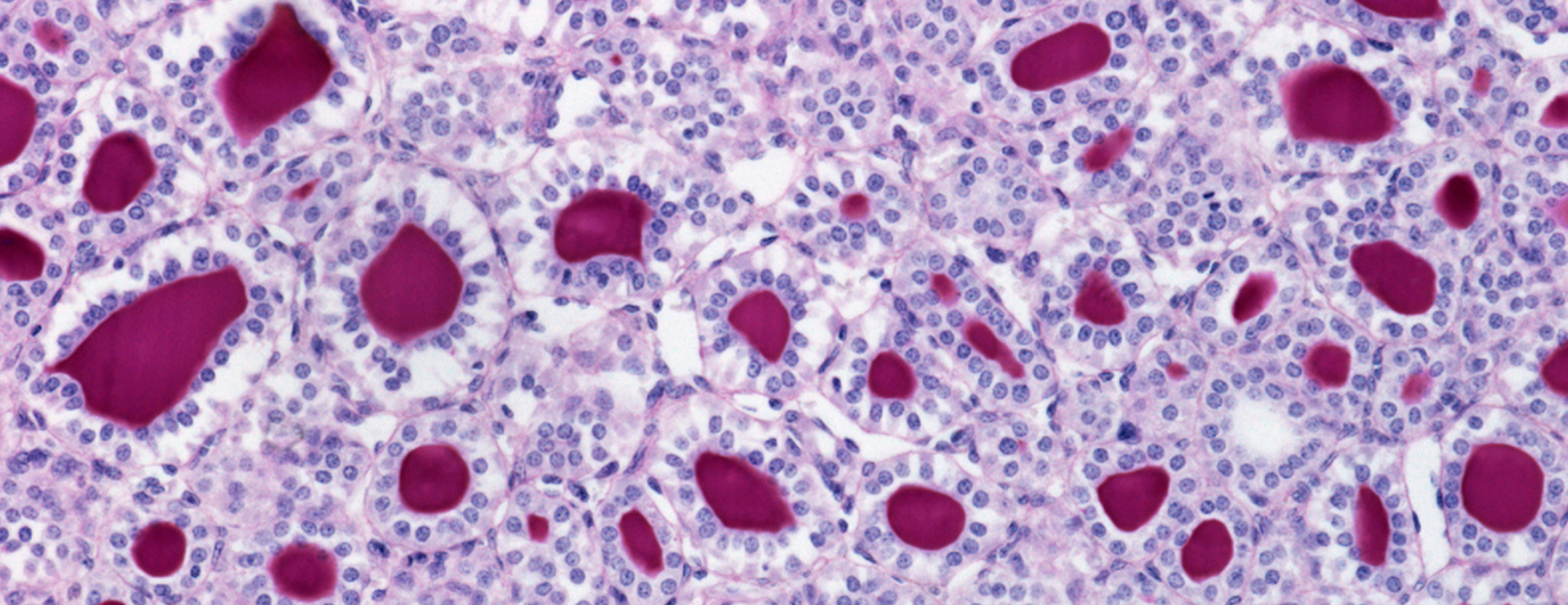
Fine needle aspiration of the thyroid
Definition
Fine needle aspiration of the thyroid gland is a procedure to remove thyroid cells for examination. The thyroid gland is a butterfly-shaped gland located inside the front of the lower neck.
Alternative Names
Thyroid nodule fine needle aspirate biopsy; Biopsy - thyroid - skinny-needle; Skinny-needle thyroid biopsy; Thyroid nodule - aspiration; Thyroid cancer - aspiration
How the Test is Performed
This test may be done in the health care provider's office or in a hospital. Numbing medicine (anesthesia) may or may not be used. Because the needle is very thin, you may not need this medicine.
You lie on your back with a pillow under your shoulders with your neck extended. The biopsy site is cleaned. A thin needle is inserted into your thyroid, where it collects a sample of thyroid cells and fluid. The needle is then taken out. If the provider cannot feel the biopsy site, they may use ultrasound or a CT scan to guide where to put the needle. Ultrasound and CT scans are painless procedures that show images inside the body.
Pressure is applied to the biopsy site to stop any bleeding. The site is then covered with a bandage.
How to Prepare for the Test
Tell your provider if you have
A few days to a week before your biopsy, you may be asked to temporarily stop taking blood-thinning medicines. The drugs you may need to stop taking include:
- Aspirin
- Clopidogrel (Plavix)
- Ibuprofen (Advil, Motrin)
- Naproxen (Aleve, Naprosyn)
- Warfarin (Coumadin)
Be sure to talk with your provider before stopping any drugs.
How the Test will Feel
If numbing medicine is used, you may feel a sting as the needle is inserted and the medicine is injected.
As the biopsy needle passes into your thyroid, you may feel some pressure, but it should not be painful.
You may have slight discomfort in your neck afterward. You may also have slight bruising, which soon goes away.
Why the Test is Performed
This is a test to diagnose thyroid disease or
Normal Results
A normal result shows the thyroid tissue looks normal and the cells do not appear to be cancer under a microscope.
What Abnormal Results Mean
Abnormal results may mean:
Thyroid disease such as goiter or thyroiditis- Noncancerous tumors
- Thyroid cancer
Risks
The main risk is bleeding into or around the thyroid gland. With severe bleeding, there may be pressure on the windpipe (trachea). This problem is rare.
References
Lai SY, Mandel SJ, Weber RS. Management of thyroid neoplasms. In: Flint PW, Haughey BH, Lund VJ, et al, eds. Cummings Otolaryngology Head and Neck Surgery. 6th ed. Philadelphia, PA: Elsevier Saunders; 2015:chap 123.
Schlumberger MJ, Filetti S, Alexander EK, Hay ID. Nontoxic diffuse goiter, nodular thyroid disorders, and thyroid malignancies. In: Melmed S, Polonsky KS, Larsen PR, Kronenberg HM, eds. Williams Textbook of Endocrinology. 13th ed. Philadelphia, PA: Elsevier; 2016:chap 14.
Review Date: 01/07/2018
The information provided herein should not be used during any medical emergency or for the diagnosis or treatment of any medical condition. A licensed physician should be consulted for diagnosis and treatment of any and all medical conditions. Call 911 for all medical emergencies. Links to other sites are provided for information only -- they do not constitute endorsements of those other sites. Copyright ©2019 A.D.A.M., Inc., as modified by University of California San Francisco. Any duplication or distribution of the information contained herein is strictly prohibited.
Information developed by A.D.A.M., Inc. regarding tests and test results may not directly correspond with information provided by UCSF Health. Please discuss with your doctor any questions or concerns you may have.





